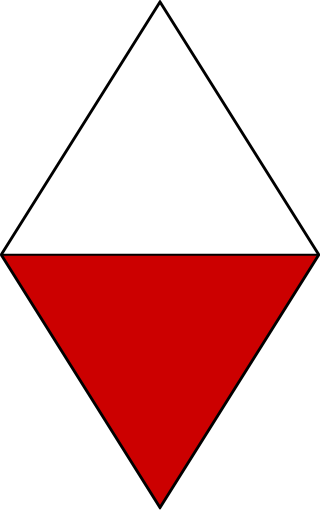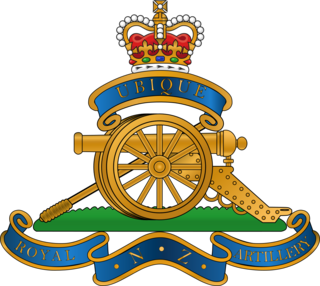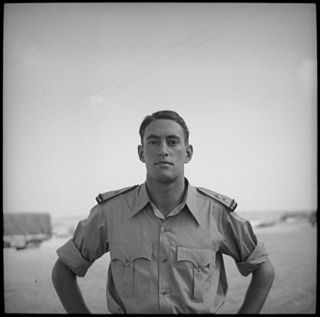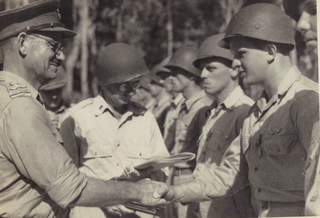Related Research Articles

The 42nd Infantry Division was an infantry division of the British Army. The division was raised in 1908 as part of the Territorial Force (TF), originally as the East Lancashire Division, and was redesignated as the 42nd Division on 25 May 1915. It was the first TF division to be sent overseas during the First World War. The division fought at Gallipoli, in the Sinai desert and on the Western Front in France and Belgium. Disbanded after the war, it was reformed in the Territorial Army (TA), in the Second World War it served as the 42nd Infantry Division with the British Expeditionary Force (BEF) and fought in Belgium and France before being evacuated at Dunkirk. The division was later reformed in the United Kingdom and, in November 1941, was converted into the 42nd Armoured Division, which was disbanded in October 1943 without serving overseas. A 2nd Line duplicate formation, the 66th Infantry Division, was created when the Territorials were doubled in both world wars.

The 54th Infantry Division was an infantry division of the British Army. The division was raised in 1908 following the creation of the Territorial Force (TF) as the East Anglian Division. During the First World War the division fought at Gallipoli and in the Middle East. The division was disbanded after the war but reformed in the Territorial Army in 1920. During the Second World War it was a home service division and did not see any combat service abroad and was disbanded in late 1943 but many of its component units went to see service in the Normandy Campaign and North-western Europe from June 1944 to May 1945.

The 2nd New Zealand Division, initially the New Zealand Division, was an infantry division of the New Zealand Military Forces during the Second World War. The division was commanded for most of its existence by Lieutenant-General Bernard C. Freyberg. It fought in Greece, Crete, the Western Desert and Italy. In the Western Desert Campaign, the division played a prominent role in the defeat of German and Italian forces in the Second Battle of El Alamein and the British Eighth Army's advance to Tunisia.

The military history of New Zealand during World War II began when New Zealand entered the Second World War by declaring war on Nazi Germany with the United Kingdom in 1939, and expanded to the Pacific War when New Zealand declared war on Imperial Japan following the attack on Pearl Harbor in 1941.

The New Zealand Expeditionary Force (NZEF) was the title of the military forces sent from New Zealand to fight alongside other British Empire and Dominion troops during World War I (1914–1918) and World War II (1939–1945). Ultimately, the NZEF of World War I became known as the First New Zealand Expeditionary Force. The NZEF of World War II was known as the Second New Zealand Expeditionary Force (2NZEF).

The New Zealand Army is the principal land warfare force of New Zealand, a component of the New Zealand Defence Force alongside the Royal New Zealand Navy and the Royal New Zealand Air Force.

The Royal Regiment of New Zealand Artillery is the artillery regiment of the New Zealand Army. It is effectively a military administrative corps, and can comprise multiple component regiments. This nomenclature stems from its heritage as an offshoot of the British Army's Royal Artillery. In its current form it was founded in 1947 with the amalgamation of the regular and volunteer corps of artillery in New Zealand. In 1958 in recognition of services rendered it was given the title the Royal Regiment of New Zealand Artillery.

The 3rd New Zealand Division was a division of the New Zealand Military Forces. Formed in 1942, it saw action against the Japanese in the Pacific Ocean Areas during the Second World War. The division saw action in the Solomon Islands campaign during 1943–1944, during which it undertook landings on Vella Lavella, the Treasury Islands and the Green Islands. Due to manpower shortages, for most of its existence the division consisted of only two infantry brigades in addition to support personnel, with its third brigade being disbanded shortly after formation. In 1944, manpower shortages in the New Zealand economy became acute led to the disbandment of the division. The majority of its manpower was returned to civilian employment, although around 4,000 men were sent to Italy to reinforce the 2nd Division, seeing further action before the end of the war in May 1945.

The Battle of the Treasury Islands was a Second World War battle that took place between 27 October and 12 November 1943 on the Treasury Islands group, part of the Solomon Islands. The battle formed part of the wider Pacific War and involved New Zealand and US forces fighting against Japanese troops. The majority of the ground forces were provided by the New Zealand 3rd Division.

The 29th Infantry Brigade was an infantry brigade unit of the British Army. It was originally raised in 1914 and saw service during the First and Second World Wars and the Korean War.
This is the order of battle for the ground forces involved in Operation Crusader, a World War II battle between the British Commonwealth and the European Axis Powers of Germany and Italy in North Africa between 18 November – 30 December 1941.

Lieutenant General Sir Leonard Whitmore Thornton, was a senior officer in the New Zealand Army.
The 36th Battalion was an infantry battalion of the New Zealand Military Forces, which served during the Second World War. Attached to the 8th Brigade, New Zealand 3rd Division, the battalion was formed in late 1941 and saw service in the Pacific against the Japanese. They were initially used for garrison duties on Fiji and Norfolk Island before being committed to the fighting in the Solomon Islands in 1943. The battalion was disbanded in late 1944 as part of a partial demobilisation of New Zealand forces, which saw some of its personnel being returned to civilian employment while others were sent to Italy as reinforcements for the New Zealand 2nd Division.

The 8th Brigade was a formation of the New Zealand Military Forces, which served during the Second World War as part of the 2nd New Zealand Expeditionary Force. Eventually forming part of the 3rd Division, the brigade served in the Pacific Ocean theatre of the war. Raised in late 1940, initially the brigade was employed on garrison duties on Fiji before returning to New Zealand in mid-1942. In December 1942, it was sent to New Caledonia where they remained until early September 1943, when they moved to Guadalcanal to prepare for operations in the Solomon Islands. The brigade's only combat operation of the war came in October–November 1943, when it captured the Treasury Islands. It was disbanded in late 1944 due to manpower shortages in the New Zealand economy.

J Force was the name given to the New Zealand forces that were allocated to the British Commonwealth Occupation Force (BCOF) which occupied Japan following the end of the Second World War. The force was deployed between 1946 and 1948, after which it was disbanded and its personnel repatriated to New Zealand.
The 35th Battalion was an infantry battalion of the New Zealand Military Forces, which served in the Pacific theatre of the Second World War from 1941 to 1944. Attached to the 14th Brigade, the battalion was formed in late 1941 and saw service in the Pacific against the Japanese as part of the New Zealand 3rd Division. It initially performed garrison duties on Fiji and New Caledonia before being committed to the fighting in the Solomon Islands in 1943. Returned to New Zealand in late 1944, the battalion was disbanded in early 1945 during a partial demobilisation of New Zealand forces. Many of its personnel returned to civilian employment while others were sent to Italy as reinforcements for the New Zealand 2nd Division. The battalion was awarded four battle honours for its various engagements during the war.
Major General Walter Sneddon McKinnon, was an officer in the New Zealand Army. He joined the military in 1935 and served in the Second World War with various artillery units of the Second New Zealand Expeditionary Force. After the war he held a series of senior positions in the army, culminating with a term as Chief of the General Staff from 1965 to 1967. In his retirement, he was Chairman of the New Zealand Broadcasting Corporation.

Brigadier Robert Amos Row, was a senior officer in the New Zealand Military Forces and a two-time recipient of the Distinguished Service Order. He served in the New Zealand Expeditionary Force during the First World War, commanding an infantry battalion. In the Second World War, he commanded the 8th Brigade during the Battle of the Treasury Islands.
The Structure of the Egyptian Expeditionary Force over the course of the First World War is shown below.
References
- Gillespie, Oliver A. (1952). The Pacific. The Official History of New Zealand in the Second World War 1939–1945. Wellington, New Zealand: Historical Publications Branch, Department of Internal Affairs. OCLC 8061134.
- McGibbon, Ian, ed. (2000). The Oxford Companion to New Zealand Military History. Auckland: Oxford University Press. ISBN 0-19-558376-0.